Native American Jewelry
inner dimensions: 2 5/8” diameter x 1 3/4” from center of the back to the back opening; back opening is 1 1/4” wide
silver (ingot or coin silver?) and high quality rectangular petit point turquoise stones set in 3 rows, flanked by small silver stones.
ex: Private Collection. Published on the cover of Southwest Silver Jewelry by Paula Baxter (Schiffer, 2001).
circa 1920s-1930s
$1200.
(J2186)
inner dimensions: 2 3/8” diameter x 1 3/4” from the center of the back to the back opening. The back opening itself is 1” wide
silver and turquoise (ingot or coin silver?)
excellent condition
ex: Private Collection
circa 1910-1920
$1850.
(J2180)
2 1/4” diameter x 1 3/4” from the back of the center to the opening; the opening is 7/8” wide
silver and turquoise
excellent condition
circa 1920s-1930s
$895.
(J2167)
inside dimensions: 2 1/2” diameter x 1 3/4” from center to back opening. Back opening is 1 1/2” wide. Center stone is 15/16” high by 7/8” wide.
coin silver or ingot and turquoise
circa 1920s-1930s
excellent condition
$1400.
(mc2358)
sterling silver and 14k gold
inside dimensions: 2 1/4” diameter x 1 5/8” from center to back opening; Back opening is 1 1/8” wide.
hallmarks: B Morgan; 14K; STERLING
excellent condition
ex: Private Collection
circa 1980s
J0715a
inside dimension: 2 3/8” diameter x 1 1/2” front to back. Opening in the back is 1 5/8” wide
coin silver (?), spandela shell (spiny oyster), turquoise, mother of pearl, jet
circa 1930s-1950s
excellent condition
ex: Private Collection
$2500.
(mc2308)
interior measurements: 5 3/8” long; 2 1/4” diameter; 1/2” wide; 13/16” opening at the back
hallmarks: D Reeves (David Reeves); STERLING
excellent condition
ex: Marcy Burns Collection
$195.
(mc2229)
inner dimensions: 2 5/16” diameter. 1 5/8” front to back opening. 1” opening
made out of ingot silver
design is chiseled and stamped
ex: Private Collection
excellent condition
$2800.
(J2234)
inside dimensions: 2 1/2” diameter; from center of the back to the opening: 2”. Opening is 1 3/8” wide. Height at tallest point is 1 7/8”.
silver, spandela shell (spiny oyster), turquoise, mother-of-pearl, jet
circa 1930s-1950s
excellent condition
ex: Private Collection
$995.
2 pins, one with repousse’ work
1 1/2” l x 7/8” wide (with repousse)
15/16” l x 1/2” wide
circa 1930s-1940s
$195.
(mc2369)
ingot that is finely polished
circa 1930s
widest point on the bracelet is 1 1/4" wide
*TO FIND YOUR BRACELET SIZE: Using a flexible tape measure or strip of paper, measure your wrist just below the bone (about where you would wear your bracelet). If you want the bracelet to fit tightly, add circa 1/4-1/2” to that measurement. If it you want it looser, add a bit more. Experiment to see what would feel comfortable. If these directions confuse you, please contact me and I will email you photos of a bracelet being measured.
excellent condition
SOLD
(J2163a)
1 1/2” wide x 1 1/4” high
sterling silver, turquoise, mother of pearl, jet
excellent condition
circa 1930s-1950s
$245.
(J2191)
1 7/16” wide x 1 1/8” high
sterling silver, jet, turquoise (high quality), spiny oyster
excellent condition
circa 1930s-1940s
$245.
(j2256)
1 3/4” wide x 1 1/2” long
sterling silver, turquoise, jet, mother-of-pearl, spiny oyster shell
excellent condition
circa 1930s
$595.
(j2209)
rectangular earrings with central oval stone
pierced back
1 5/8” long x 1/2” wide
sterling silver and onyx
excellent condition
ex: Marcy Burns Collection
$45.
(J0649)
3/4” wide x 1” high
channel inlay
sterling silver, turquoise, jet, mother of pearl, spiny oyster
ex: Private Collection
$595.
(J2245)
inner dimensions: 2 3/8” diameter x 1 3/16” from the middle of the inside to the end of the cuff. The opening is 1.5”.
sterling silver with channel inlay of turquoise, mother of pearl, abalone and more
circa 1950s
$950.
(j2254)
A Zuni bracelet with the depiction of Apache crown dancers is fairly rare. This bracelet is in excellent condition and is fresh to the market.
1 1/4” diameter
sterling silver and turquoise
excellent condition
ex: Private Collection
$795.
(mc2370)
circa 13 1/2” long
made with olive shell, turquoise, and melon shell
circa 1980s
excellent condition
$450.
(J0411)
1 1/2” diameter
sterling silver and turquoise
unsigned
circa 1940s-1960s
ex: Private Collection
$195.
(mc2373)
clasp is 1.5” wide at the widest point x 2” high
turquoise is very high quality, possibly Blue gem
sterling silver
circa 1950s-1970s
excellent condition
ex: Private Collection
$1250.
(mc2316)
5” wide
center has a circle of repousse’ work, which is very difficult to create
intricate designs of arrows, whirling logs, half-crescents that are commonly found on Fred Harvey jewelry
excellent condition
circa 1920s-1930s
ex: Private Collection
$750.
(mc2364)
5/8” wide x 1/2” high
sterling silver and turquoise
excellent condition
circa 1940s-1960s
ex: Private Collection
$125.
(mc2372)
silver balls and squash blossoms strung on wire with large naja
high quality turquoise stones
25" long
circa 1900-1920s
excellent condition
ex: Private Collection
$6500.
(mc2354)
12 round conchos on the belt + one that is loose
(belt itself has incorporated a smaller, narrrower one)
37 1/4" long x 2 1/2" wide as currently configured
silver and leather
ex: Private Collection
circa 1900-1920s
excellent condition
$5500.
(mc2356)
It is rare that a Navajo (Dine') concho belt of this age and quality come to the marketplace. As is evident by the construction of the belt, the conchos appear to have been on a smaller and narrower belt at one time. There are two conchos (one of which is loose) which are the same age as the other conchos but have a different yet similar design.
29" long x 5/16" wide. Each concho is 1/2" wide x 5/16" on 5/8" wide leather with metal clasp
silver and leather
excellent condition
circa 1930-1950
ex: Private Collection
$1500.
(mc2359)
This vintage Navajo (Dine') concho belt is very wearable. The small conchos can fit through belt loops or the belt can rest comfortably on your waist or hips.
18" long. Largest circle (in the center) is 1 1/4" diameter. The smallest circles are 3/4" diameter.
sterling silver and turquoise
unsigned
The necklace itself is made out of handmade silver links.
circa 1940s-1960s
$850.
(mc2365)
inner measurements:
2 1/4" diameter x 1 7/8" front to back. Opening is 1 1/4"
excellent condition
ex: Private Collection
circa 1920s-1940s
$695.
mc2361
1 5/8" diameter x 1/2" wide
sterling silver
circa 1920-1930
excellent condition
ex: Private Collection
$135. (sold as a set)
(mc2362)
The railroad went to the West beginning in the late 19th century and shops were opened at many of the railroad shops. Tourist items such as these Navajo napkin rings were sold to those traveling by. These two napkin rings are beautifully made and they have descended in a private collection.
- 1930-1940S (1)
- Acoma (1)
- Belts (1)
- Kewa (1)
- Santo Domingo (1)
- belt buckle (1)
- hair fasteners (1)
- pottery (1)
- 1930s-1950s (2)
- bolo (2)
- Necklaces (3)
- Earrings (4)
- necklaces (4)
- Zuni (5)
- Pueblo (7)
- Contemporary (9)
- early 20th Century (9)
- Navajo (10)
- Navajo bracelet (11)
- Pins/Brooches (13)
- contemporary (18)
- jewelry (24)
- Southwestern (26)
- Bracelets (30)
- all Indian jewelry (60)
- all native amer. jewelry (60)
Our gallery focuses on the sale of antique Native American jewelry dating from the late 19th century through the 1950s, including works by Navajo and Pueblo (Zuni, and Hopi) artists. The makers of the majority of these works remain unidentified as the artists did not begin to sign their jewelry until the late 1940s.
THE MAKERS OF SOUTHWESTERN AMERICAN INDIAN JEWELRY
The Navajos learned silversmithing from the Spanish. From 1870s-1900, they worked primarily in ingot silver, using hand-made tools. Silver is a difficult medium to work, requiring extremely high temperatures in the firing, but the Navajos mastered it and developed designs using dies, chisels and stamps. By about 1900, the Navajo began to incorprate stones into their work. The silverwork, however, remained the most important part of the design of the jewelry that they made (most especially bracelets, necklaces, brooches, rings, earrings and ketohs).
The Pueblo and Hopi Indians are descendants of the Anasazi Indians. They learned jewelry-making from their ancestors. The Zuni focused primarily on fine stone-work, utilizing turquoise, spiny oyster (spondylus), coral, onyx and clam shell, some of which was acquired by trade with coastal peoples.
Pueblo silverwork is often difficult to distinguish from the Navajo during the earlier days of silverworking. However, in the 1930s and 1940s, the Zuni began utilizing a lot of very small stones, sometimes setting each stone in its own bezel, sometimes setting it in a silver channel, and sometimes setting it with precision next to other stones.
The Indians from Santo Domingo Pueblo worked almost exclusively with stones, making necklaces and earrings of heishi and other stones or setting stones in old battery casing or phonograph records (1930s-1940s).
The Hopi developed a distinctive style of silverwork using silver overlay after World War II, a method that continues through to current times.
Stamping the jewelry with the maker's name as well as silver content of "sterling" doesn't really begin until after World War II. Even then, it takes at least a decade for signatures to become common. Some of the jewelry made at Zuni during the tenure of C G Wallace is attributable by the items that sold at the Wallace sale at Sotheby Parke Bernet ins 1975. In the catalog for that sale, C G Wallace identified makers of specific items in the sale.


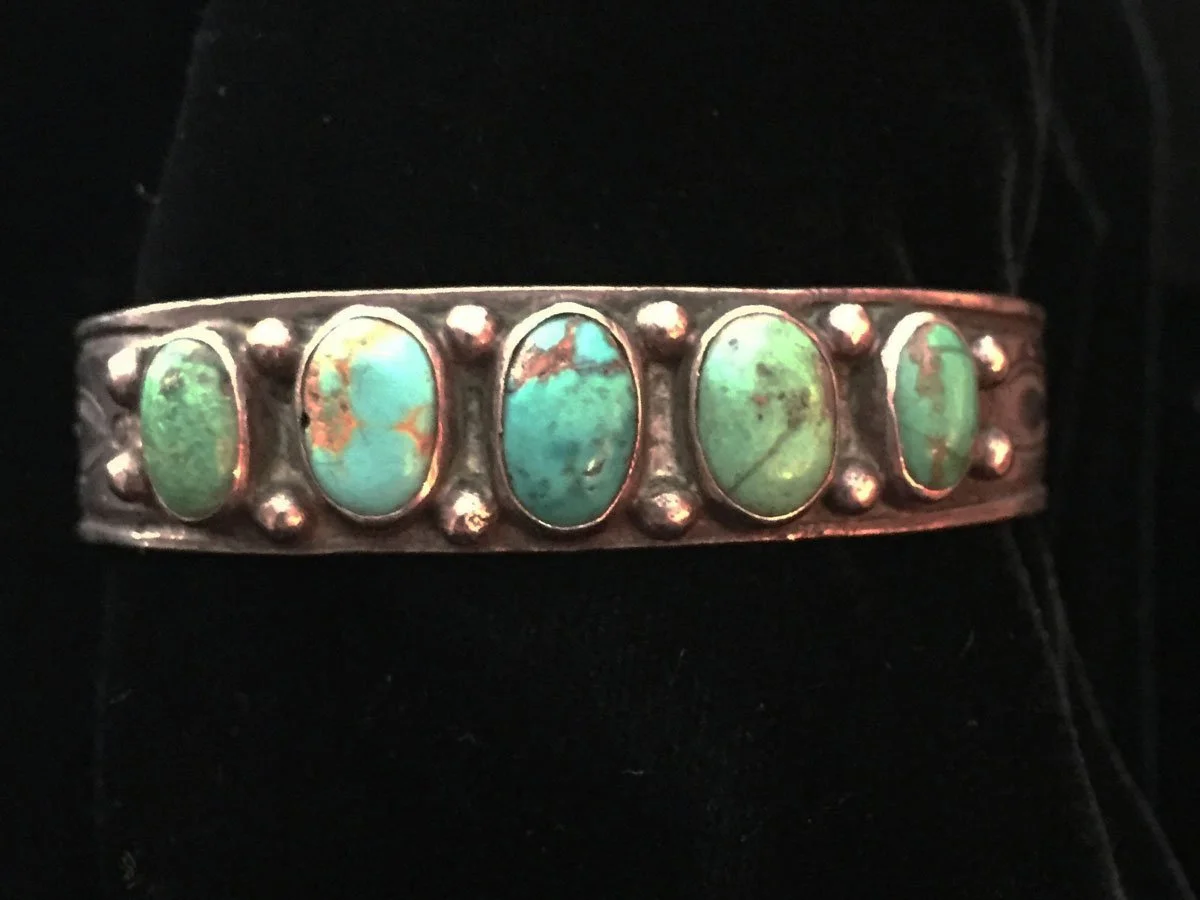

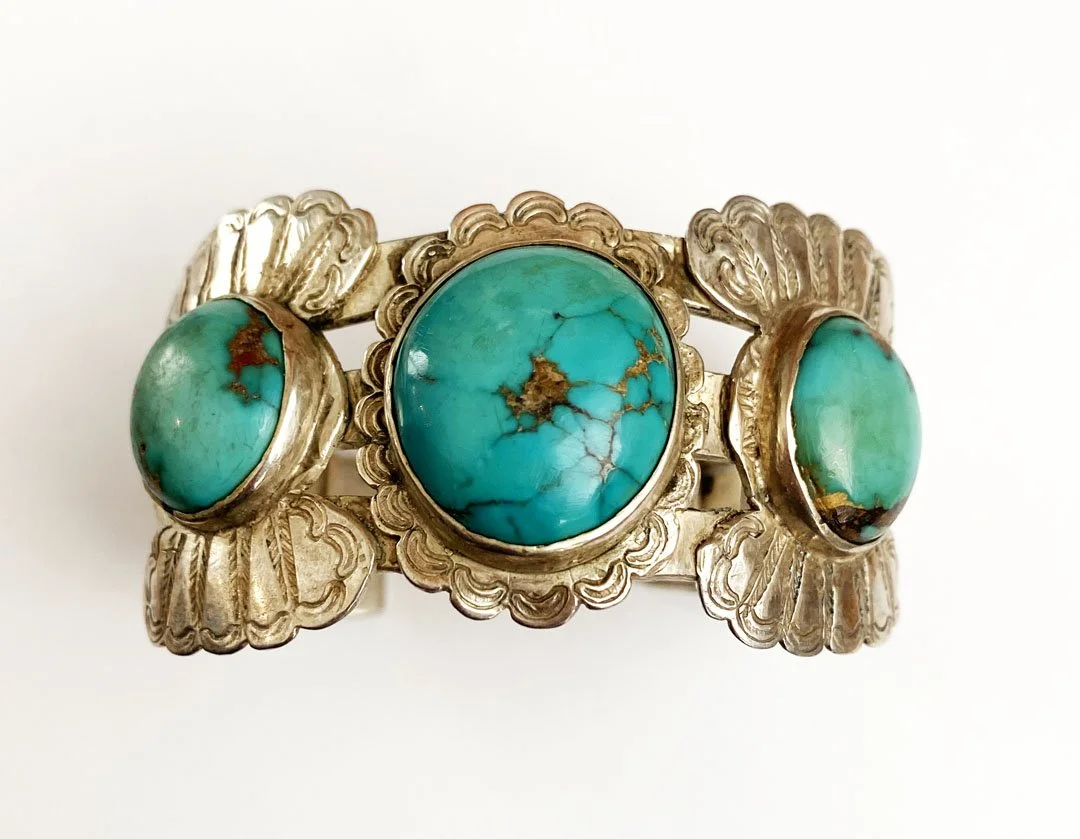

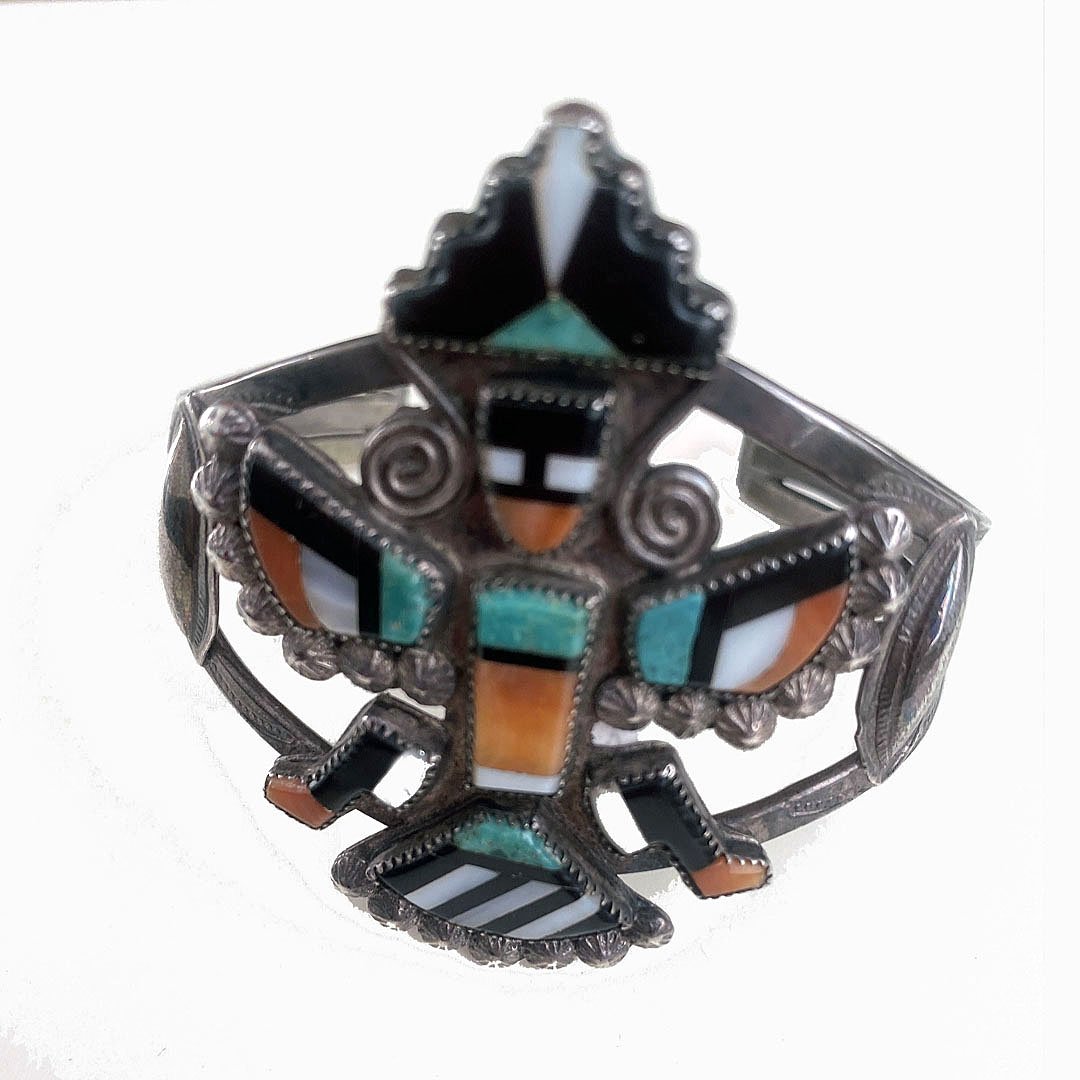





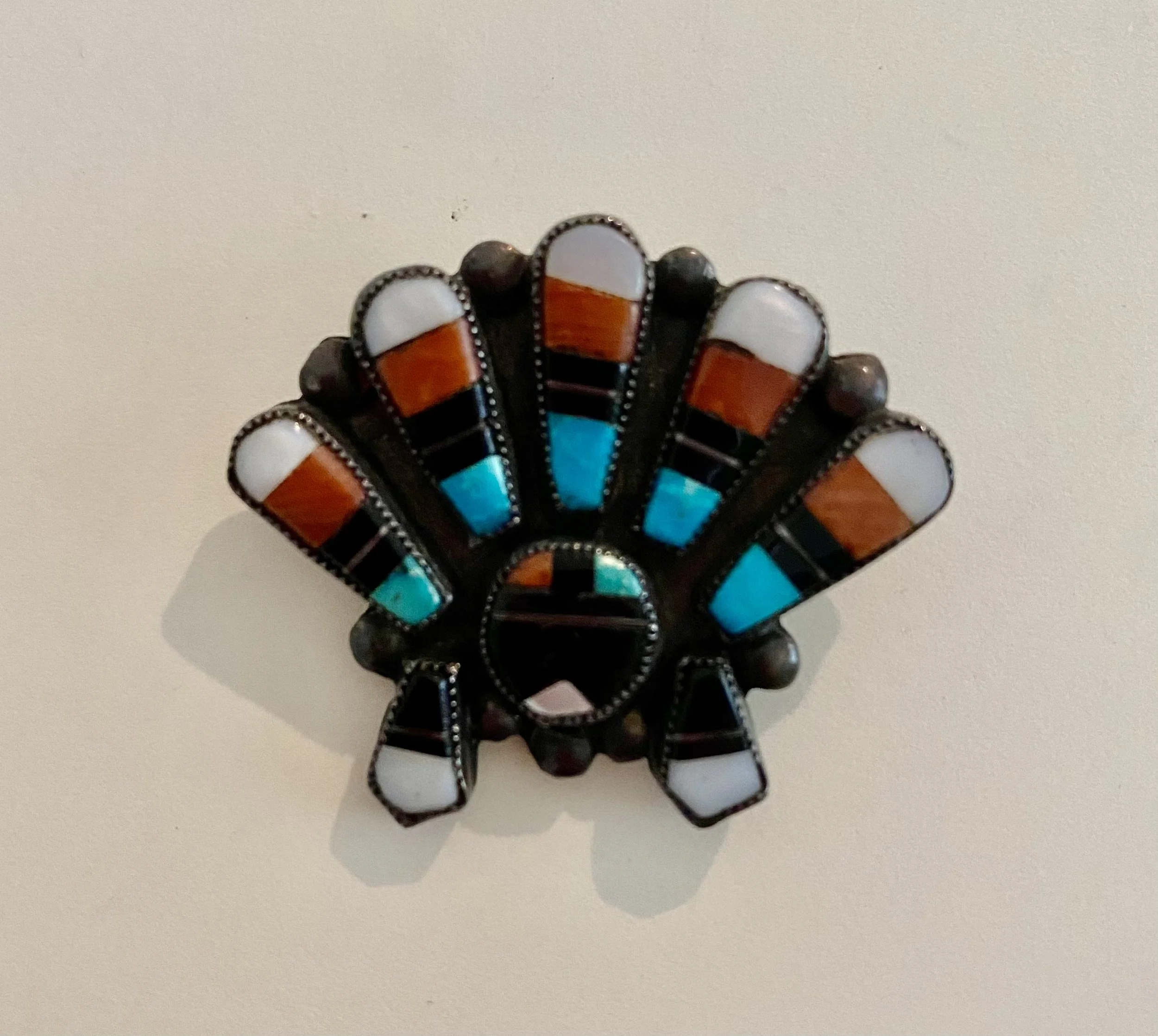
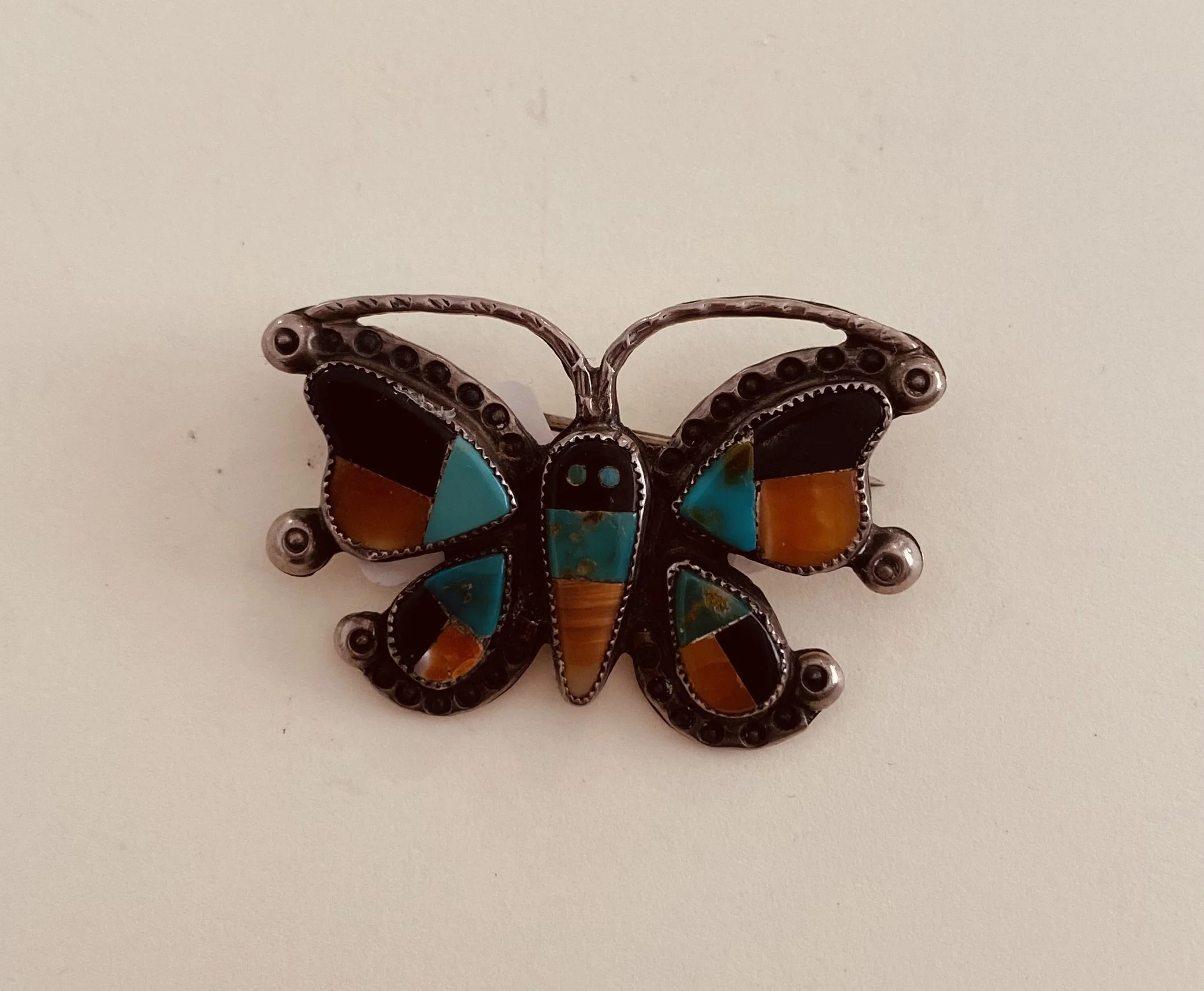

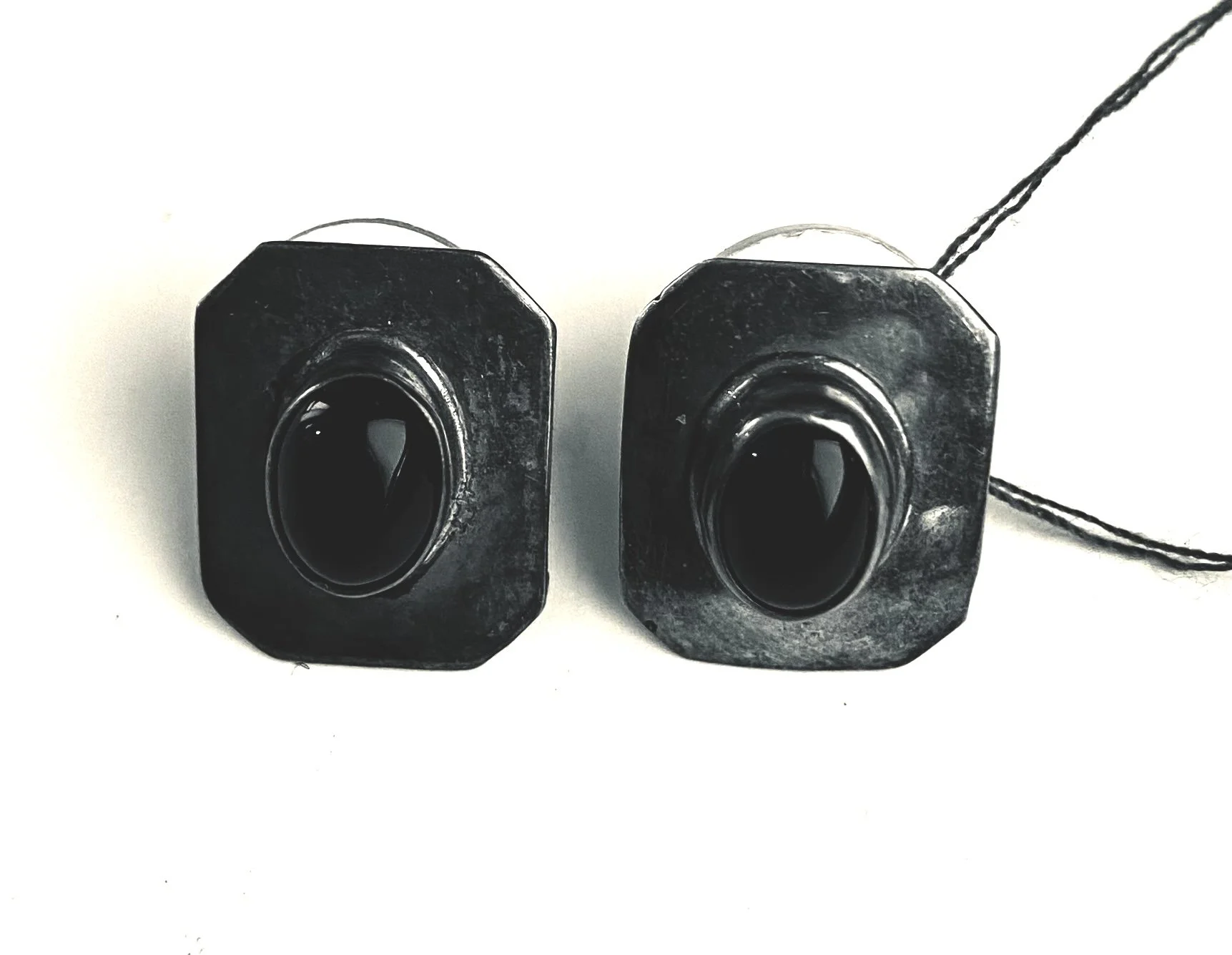


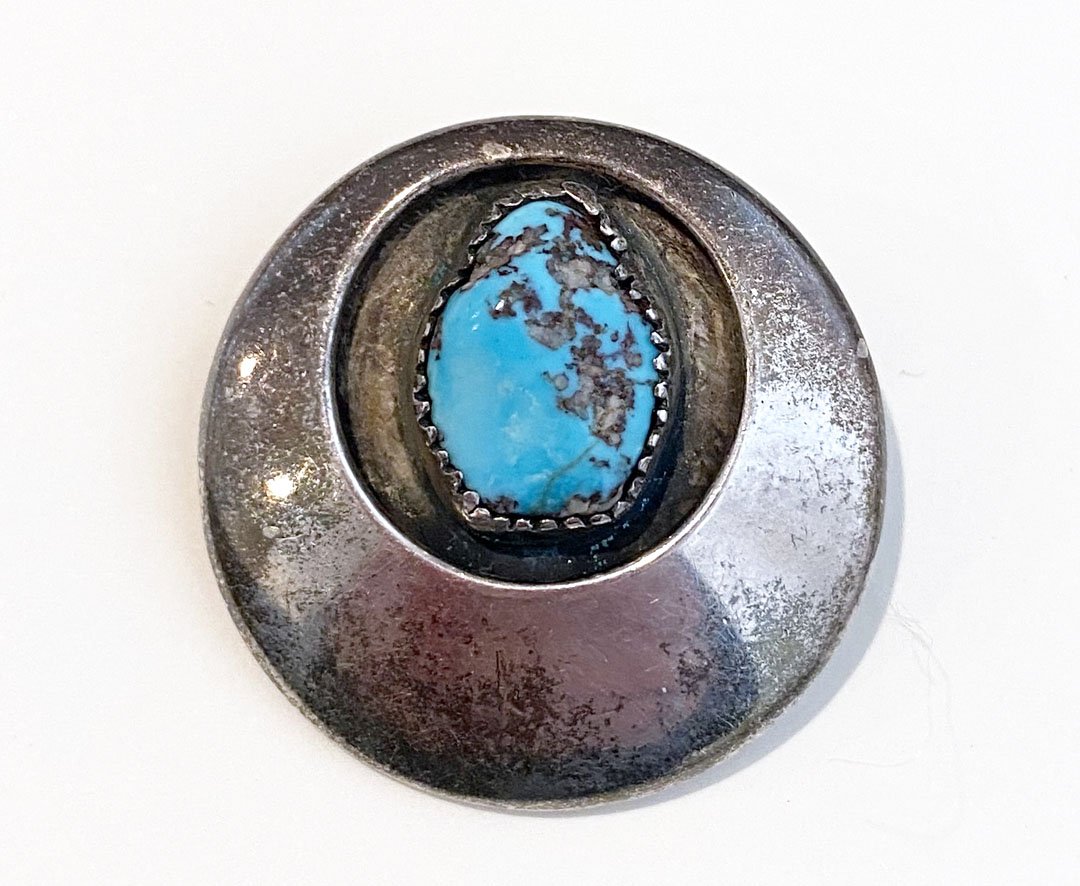

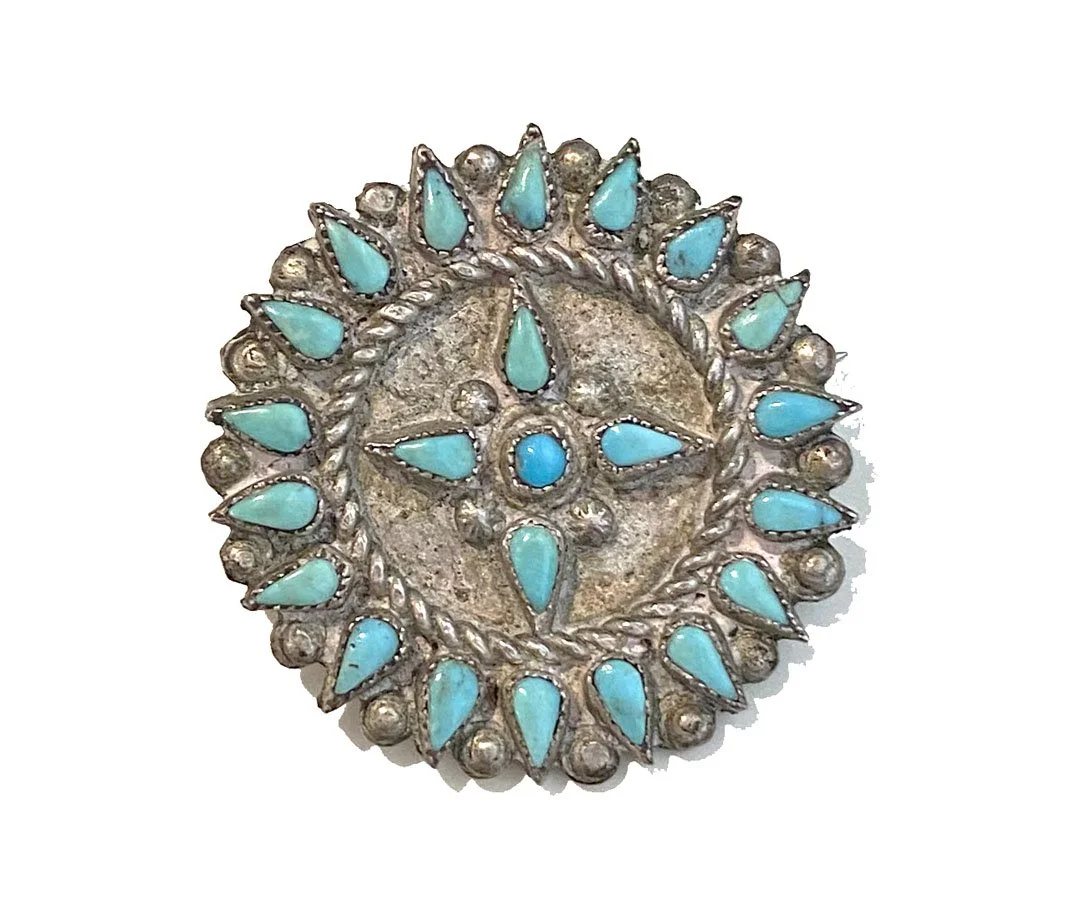
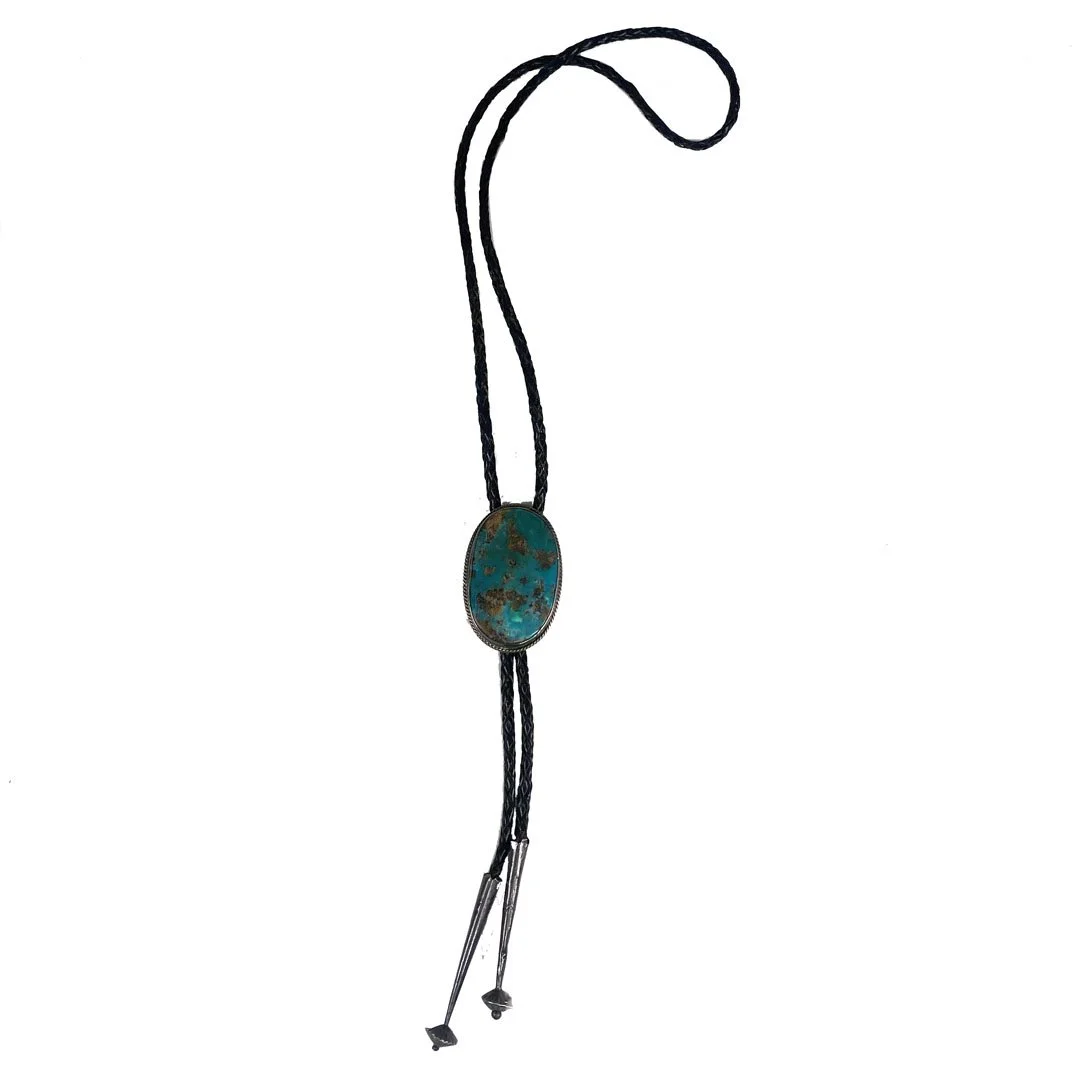
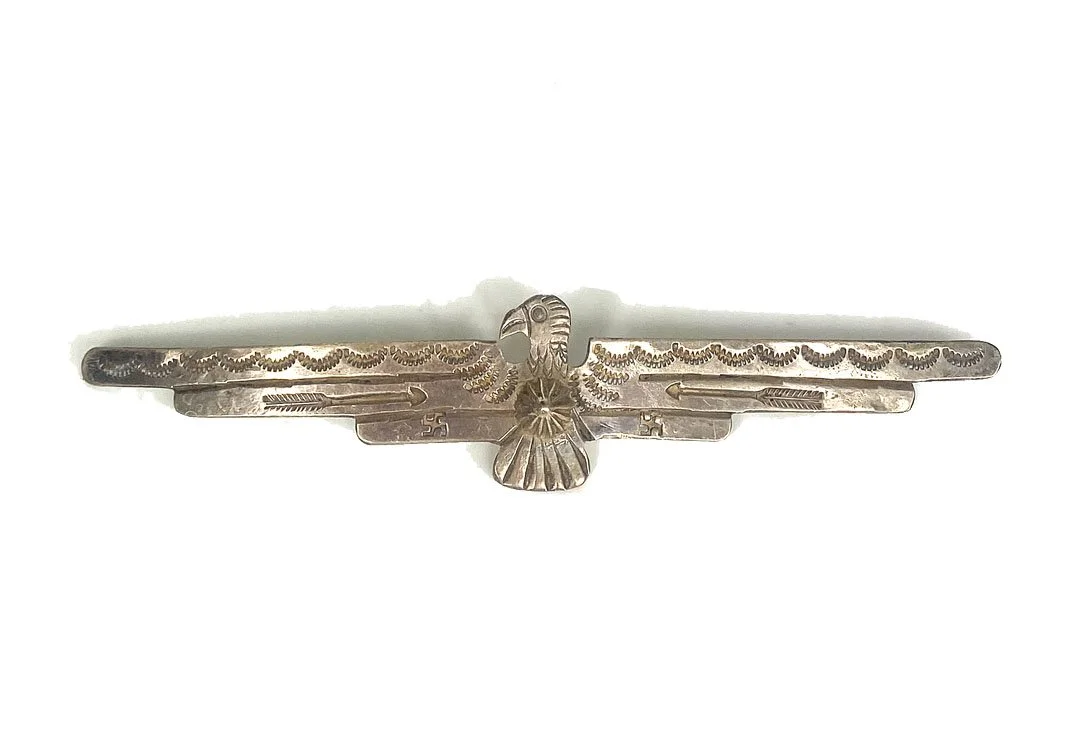
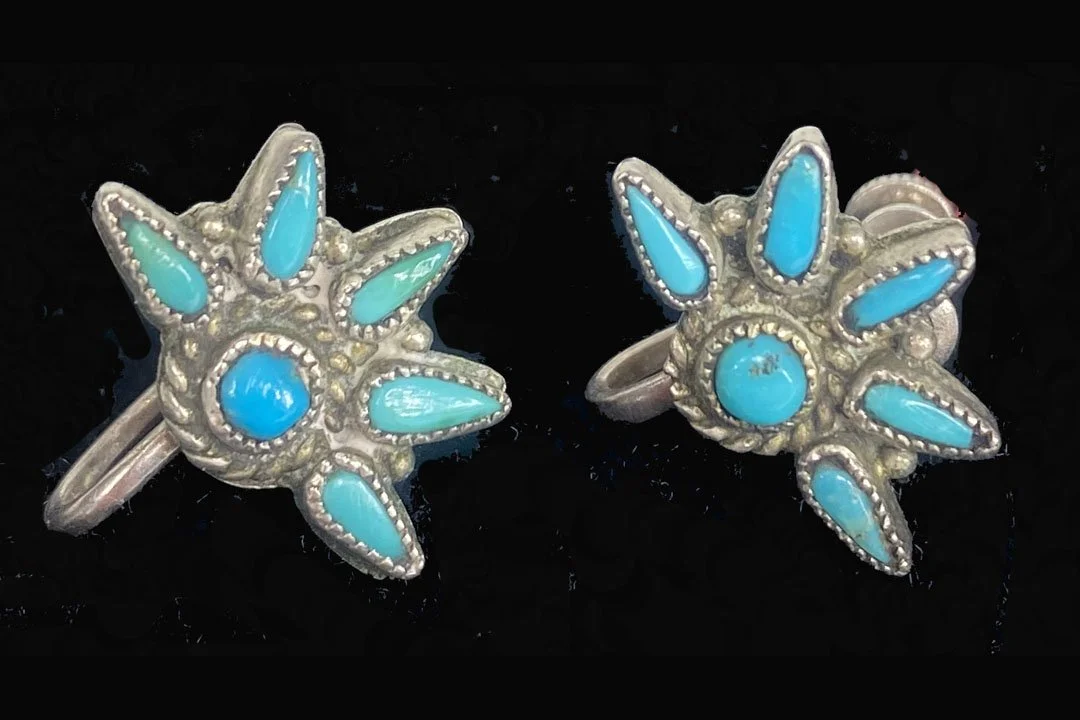

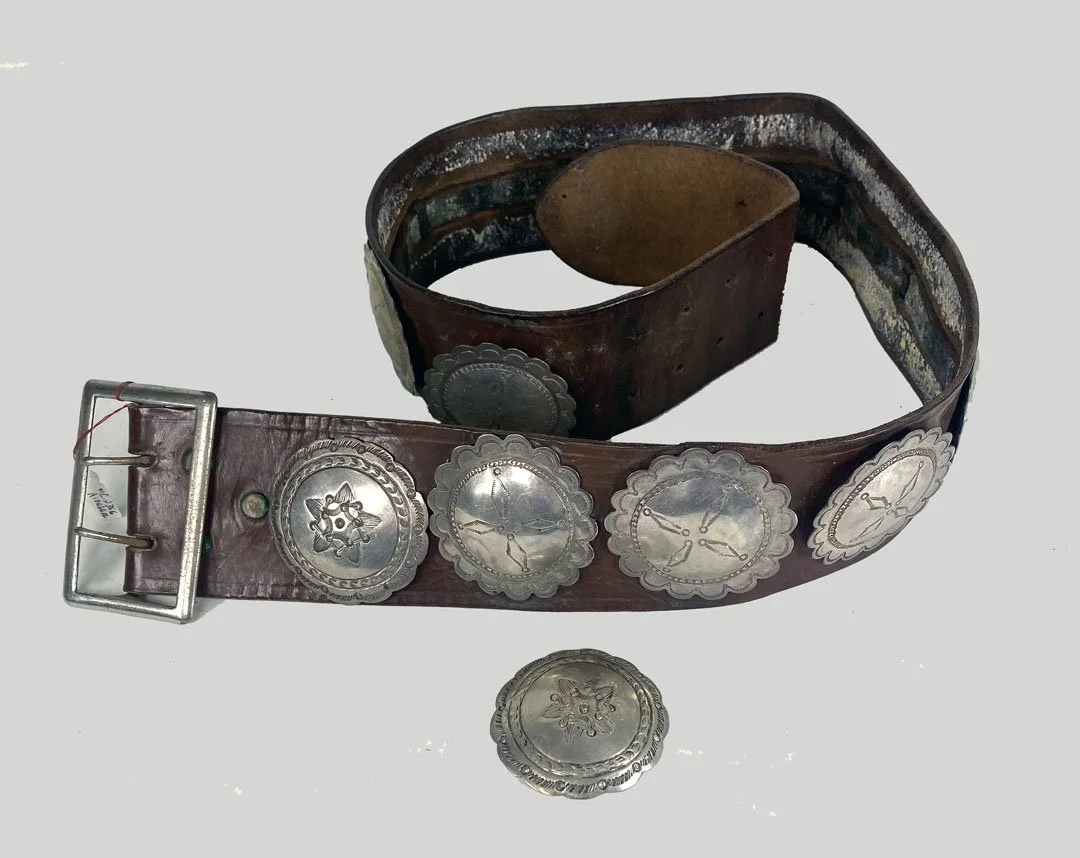



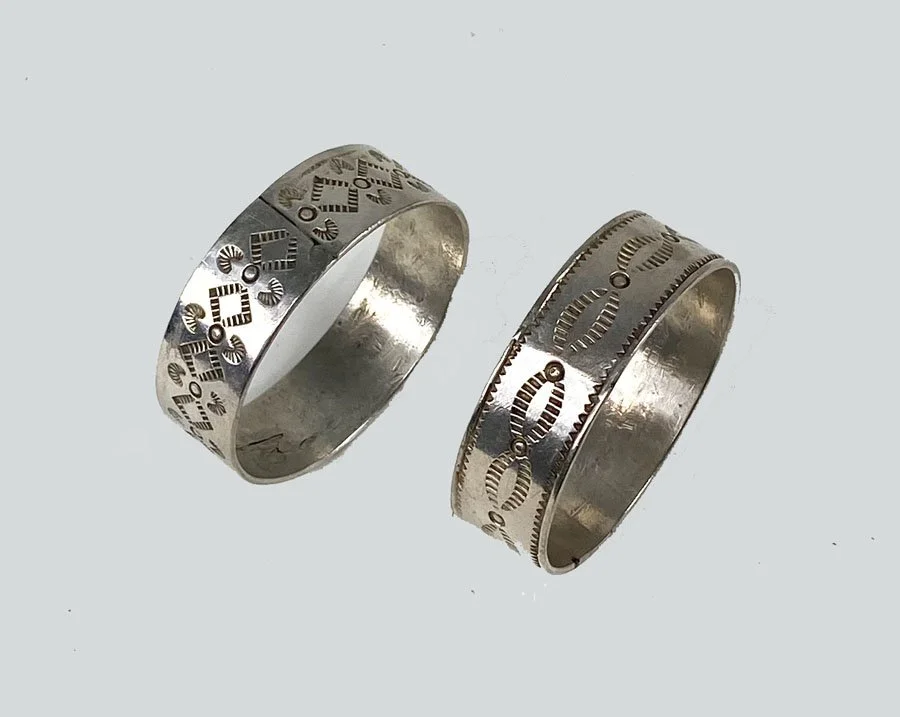
Interior dimensions: 2 1/4” diameter x 1 5/16” from the interior back to the opening at the back. The back opening is 1” wide.
stamped STERLING and TAHE
excellent condition
circa 1980s
$350.